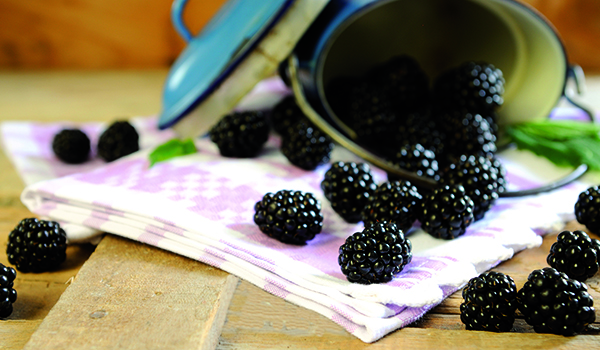This is the month of the great harvest. These are the fantastic fruit, vegetables and fish that is in season right now…

Blackberries – more
There are few family activities more enjoyable than foraging for blackberries towards the end of summer. Many people these days avoid blackberries that have been growing near main roads, and with good cause, but more important is to leave the ones that have grown low on the bush, where they can be polluted by splashed mud and passing animals. Wear old clothes, too, because the juice does stain, and give children light gloves to protect them from the thorns. While blackberries are at their best straight from the bramble, you will probably pick more than you need, but the good news is that they freeze very well. The trick is to freeze them individually on a metal tray, then release them with a bang on the bottom of the tray and bag them up, quickly, before returning them to the freezer.
Aubergines – melanzane
This is a vegetable (actually, botanically, it’s a berry, but it’s treated as a vegetable) that needs a lot of heat and humidity to grow, and although it is just about possible – with a great deal of care, attention and skill – to grow it in southern parts of the UK, most of Europe’s commercial product comes from Italy. Melanzane alla Parmigiana, a bake made with aubergines, plum tomatoes, Parmesan and mozzarella, is a northern Italian classic, but the aubergine, which sucks up other flavours like a sponge, is very versatile and appears alongside all manner of guest stars in Italian kitchens. Here we’ll show you a recipe that combines it with Quartirolo Lombardo, an Italian cheese with a very long tradition which can be hard to find in the UK, but which is much like feta. When you buy an aubergine, it’s important to check that the flesh looks bright and shiny. If it’s wrinkled and dry, it’s old, and you don’t want it. The stem should look fresh too. And pick it up in your hand – a fresh aubergine will be full of water and should feel quite heavy.
John Dory – pesce san pietro
In season throughout the summer, the John Dory is a strange-looking fish – olive-yellow in colour with an oval, flat body and a spiny head – but its firm flesh and almost sweet flavour make it popular with chefs all over the world. The Italians call it St Peter’s Fish because the small dimple on its flank is supposed to be the imprint of the biblical fisherman’s thumb. (Why we call it John Dory is not known, though it’s probably a corruption of some French, or possibly Spanish, popular name for it. We don’t need to know.) What we do need to know is that it is delicious grilled, sautéd or poached, then sprinkled with a blend of coriander, garlic, lemon juice and extra-virgin olive oil. We also need to know that while its distribution is wide, it is unfortunately frequently caught as bycatch by trawlers and, though not yet on the endangered list, is considered to be only marginally sustainable. We have a typically Italian variation here that involves black olives and fresh plum tomatoes.
Hazelnuts – nocciole
We know from the evidence of ancient firepits that the hazelnut was a staple food in prehistoric Britain. This was at a time when much of Britain was covered in hazel forest. The Celts revered it and considered it a symbol of wisdom. But the hazel has never been unique to Britain: it grows across Europe. Today, Italy is Europe’s largest producer of hazelnuts, with the nocciolo tree cultivated extensively in Campania, Lazio, Sicily and, notably, Piedmont, where the nuts are made into torrone and gianduiotti. Indeed, the Tonda Gentile del Piemonte (literally, ‘the round noble from Piedmont’), also known as the Nocciola Piemonte, is an IGP (Protected Geographical Indication) product. Here, and across Italy, the hazelnut also features in many biscuits and cakes. And, of course, Nutella. It’s big business.
Also in season…
Apples – mele
Chicory – cicoria
Chilli peppers – peperoncini
Damsons – susine selvatiche
Duck – anatre
Elderberries – bacche di sambuco
Lobster – aragoste
Pears – Pere
Porcini – Porcini
Rabbit – Coniglie
Sweetcorn – Mais dolce
Tomatoes – Pomodori
